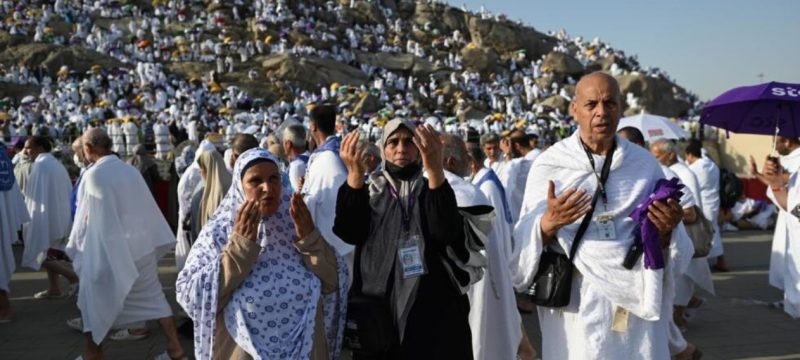The annual Hajj pilgrimage has officially commenced, with nearly two million pilgrims settling into the expansive tent city of Mina. As one of the five pillars of Islam, Hajj attracts millions of Muslims worldwide each year, offering a once-in-a-lifetime spiritual experience for those who are able to participate.
The air in Makkah is filled with the resonant chants of “Labbaik Allahumma Labbaik” as pilgrims begin their sacred journey. This year, a total of 88,301 Pakistani pilgrims are participating through the government’s Hajj scheme, while another 27,012 are performing Hajj via private operators. They have been transported to Mina by bus from residential areas such as Aziziyah, Naseem, and Batha Quraish.
Read more: Hajj 2025: Double-Decker Tents Unveiled in Mina to Boost Pilgrim Comfort
After donning the ihram garments and performing two units of prayer, the pilgrims declared their intention for Hajj before departing for Mina. On the morning of the 9th of Dhul-Hijjah, they will proceed to the plains of Arafat to perform the most crucial ritual of Hajj — Wuquf-e-Arafat (standing at Arafat). Following the sermon at Arafat, pilgrims will offer combined Zuhr and Asr prayers and remain there until sunset.
Without performing Maghrib prayer at Arafat, pilgrims will move to Muzdalifah, where they will combine Maghrib and Isha prayers and spend the night under the open sky. While at Muzdalifah, they will collect pebbles for the symbolic stoning of the devil. On the morning of the 10th of Dhul-Hijjah, they will perform Ramy al-Jamarat (stoning of the large devil) by throwing seven pebbles, followed by sacrificial rites. Male pilgrims will then shave their heads (halq), while females will trim their hair, marking the completion of the ihram state.
On the 11th of Dhul-Hijjah, pilgrims will stone all three Jamarat (small, medium, and large devils) with seven pebbles each. They will then proceed to the Holy Kaaba for Tawaf al-Ziyarah (Farewell Tawaf), followed by Sa’i — the ritual walking between Safa and Marwah. The stoning rituals continue on the 12th of Dhul-Hijjah, after which pilgrims may return to their accommodations or stay in Mina to complete the rites on the 13th.
Chanting “Labbaik Allahumma Labbaik” (“Here I am, O God, here I am answering Your call”), over 1.5 million pilgrims arrived in Mina on Wednesday, marking the Day of Tarwiyah and the official start of Hajj. Pilgrims began arriving early in the day, with Saudi authorities executing an impeccable transportation plan to ensure smooth and safe movement. By afternoon, over 8,000 buses had transported pilgrims from Makkah to Mina, creating an atmosphere filled with devotion.
This year, more than 1.47 million international pilgrims are taking part, alongside hundreds of thousands of domestic pilgrims. Among them, 2,443 pilgrims from 100 countries are guests of the Custodian of the Two Holy Mosques, King Salman.
Upon arrival in Makkah on Tuesday, pilgrims performed Tawaf Al-Qudum (the Tawaf of Arrival), an essential rite of Hajj, before heading to Mina. The valley echoed with the Talbiyah recitations, fostering a deep sense of unity and spiritual commitment.
Following the tradition of Prophet Muhammad (PBUH), pilgrims will spend the night in Mina in prayer and reflection, preparing for Wuquf at Arafat on Thursday, considered the most vital pillar of Hajj.
Saudi authorities, in cooperation with global Hajj missions, have mobilized over 40 government agencies and deployed 250,000 personnel to manage the pilgrimage. Advanced technology, including artificial intelligence and drones, is extensively used to monitor crowds and enhance services.
Grand Mufti Sheikh Abdulaziz Al-Sheikh, head of the Council of Senior Scholars, welcomed visitors at his Mina residence on Wednesday and appointed five scholars to provide religious guidance during Hajj. Sheikh Abdulrahman Al-Sudais, head of Religious Affairs at the Grand Mosque and the Prophet’s Mosque, urged pilgrims to continue reciting the Talbiyah until the stoning ritual at Jamarat Al-Aqaba on the 10th of Dhul-Hijjah.
Pilgrims have been advised to pray on time, following the prescribed format of shortening but not combining prayers, except for Maghrib and Fajr, which should be offered in full.
With temperatures soaring, the Ministry of Health issued heat advisories urging pilgrims to stay hydrated, use sun protection, and limit physical activity during peak heat hours (10 a.m. to 4 p.m.). Many pilgrims have been seen using white umbrellas for shade as Saudi Arabia enhances heat-mitigation measures following last year’s severe heat wave.
Spanning five to six days, Hajj remains one of the world’s largest annual religious gatherings, embodying the spiritual devotion of millions of Muslims worldwide.









